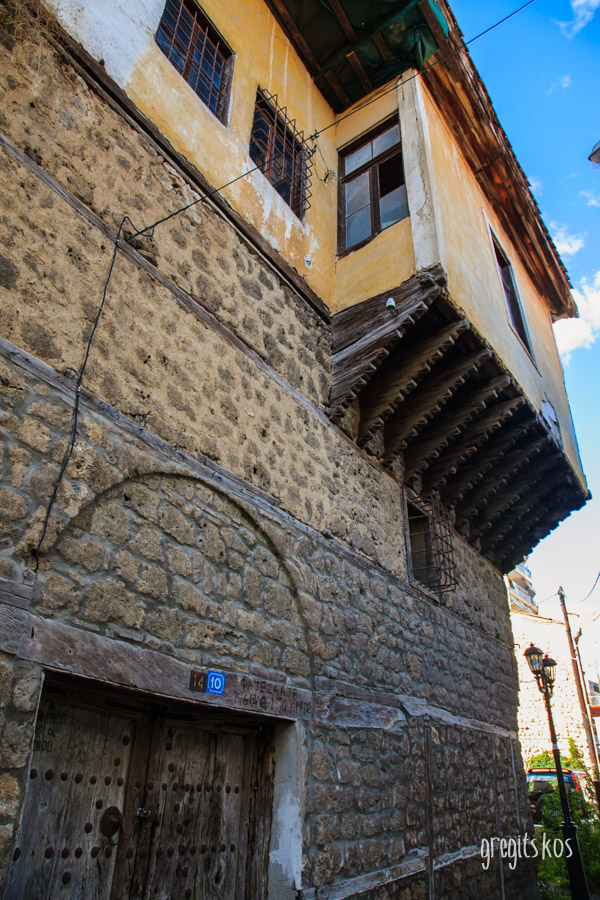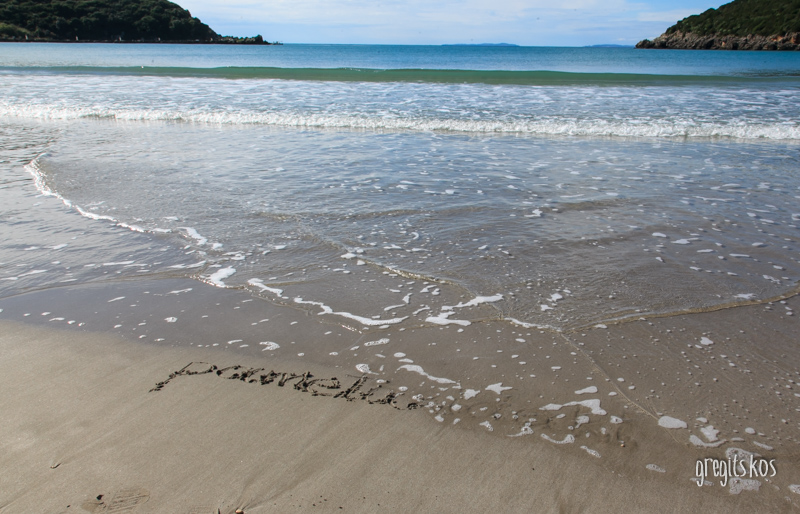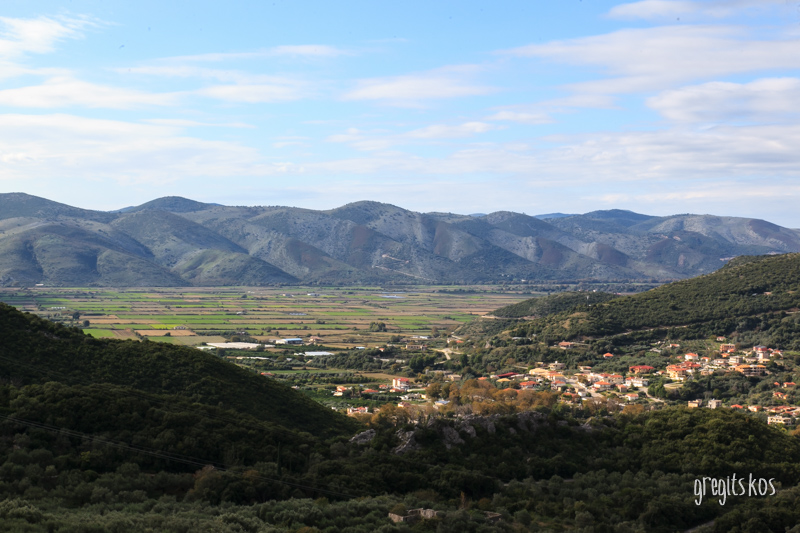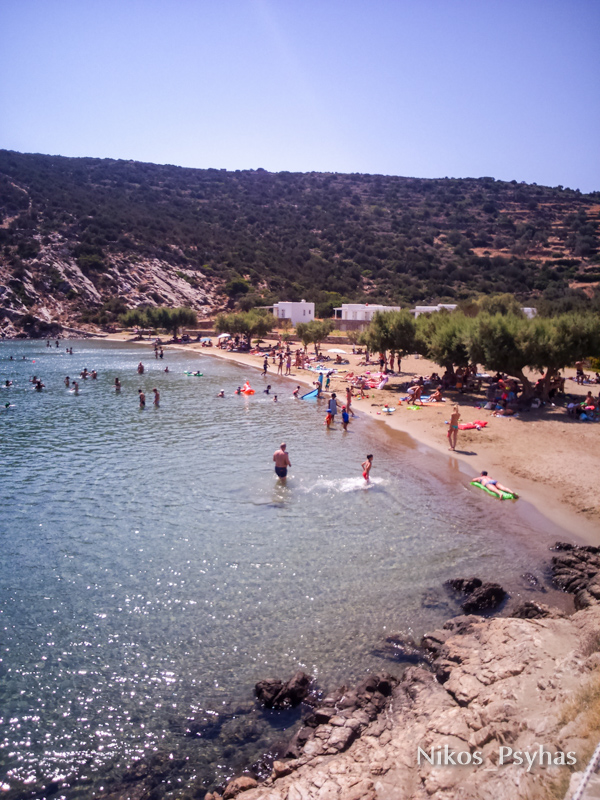
by katerina | Dec 28,2016 | mountain resorts
 “Agkistro” (= hook ), a small village close to the borders with Bulgaria, was picked as a relaxing destination during our Christmas holidays and it very much justified our choice! So here are all the secrets so that you can enjoy what it offers!
“Agkistro” (= hook ), a small village close to the borders with Bulgaria, was picked as a relaxing destination during our Christmas holidays and it very much justified our choice! So here are all the secrets so that you can enjoy what it offers!
So we set off from Veria, on the second day of Christmas, choosing to follow the road to Kerkini and Ano Poroia. On our stop at Poroia we came upon the village’s Christmas feast: Every year, they organize the “Gournosfagia” ( slaughtering of pigs) at the main square. Smoked piglets, frying pancakes, crumbs and” tsipouro” are treated to visitors accompanied by music of course! We drank our coffee at “Nastou View Hotel” at the highest point of the village, enjoying a wonderful view of Lake Kerkini.
A 40 ‘drive led us to “Agkistro” through Promachonas. “Agkistro” is the northernmost village of the prefecture of Serres, built at the foot of the homonymous mountain (Mount Agkistro or “Tsigelli” at an altitude of 1,294m), near the well-known “Fort Rupel”, right next to the border line with neighboring Bulgaria. In the “Wooden Village”,  Our hotel welcomed us with smiles and our good mood was enhanced when we got into the warm rooms (built with wooden trunks), fireplaces and exposed roofs. An intimidating environment especially when it got dark showing up the impressive Christmas decoration!
Our hotel welcomed us with smiles and our good mood was enhanced when we got into the warm rooms (built with wooden trunks), fireplaces and exposed roofs. An intimidating environment especially when it got dark showing up the impressive Christmas decoration!
Time to eat, and since we came all the way, we had to try the homegrown trout cooked on charcoal. The waters of “Strymonas” river feed the village’s fish farm (you can navigate through the tanks), which also has a tavern that is open since 1977 (PEKAM). In its vintage decor, as if the we were transferred back in time, we enjoyed our fresh fish! The smoked trout was very delicious!



 After coffee and chatting in the main building of “Wooden Village”, Antonia, the polite receptionist, fully enlightened us about the region! In the evening we went to the “Eight” café /bar of “Paroraia” Boutique Hotel . A wonderful place with cozy atmosphere and fine music! A must! We spent several hours of our 2day vacations on its sofas, around the fireplace enjoying our coffee, tea or drink!
After coffee and chatting in the main building of “Wooden Village”, Antonia, the polite receptionist, fully enlightened us about the region! In the evening we went to the “Eight” café /bar of “Paroraia” Boutique Hotel . A wonderful place with cozy atmosphere and fine music! A must! We spent several hours of our 2day vacations on its sofas, around the fireplace enjoying our coffee, tea or drink!
Second Day: Morning walk in the village and visit to “Fort Rupel”
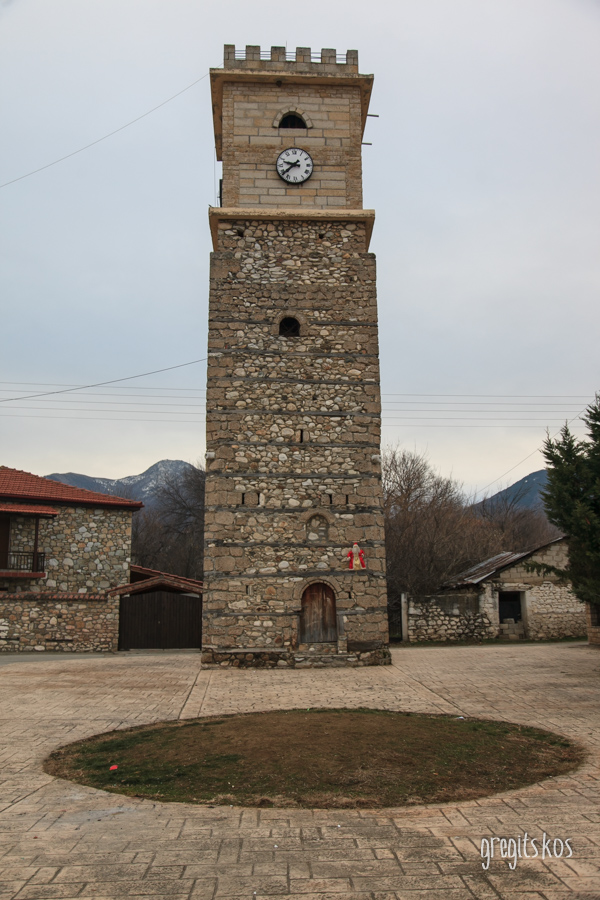 On our walk, we came by the square which is dominated by the stone, Byzantine tower, which was used as a prison or even as a place of execution during the Ottoman domination. Today it is just a clock, depicting the local architecture.
On our walk, we came by the square which is dominated by the stone, Byzantine tower, which was used as a prison or even as a place of execution during the Ottoman domination. Today it is just a clock, depicting the local architecture.
Following the signs from “Promachonas” (14km away), we drove to the “Fort Rupel”, incident to the resistance and heroism of the Greeks during the war with the Germans. It was never occupied, but was surrendered after the capitulation to the Germans on 10/4/1941. The fortress today is accessible (free of charge), daily from 9.00 to 13.00 (entrance accepted until 12.30). The tour includes first a brief presentation of the external space, a brief analysis of the military connections in this area at that time, and finally a visit into the “deep” land with the shelters, blockhouses and endless underground galleries. Impressive!
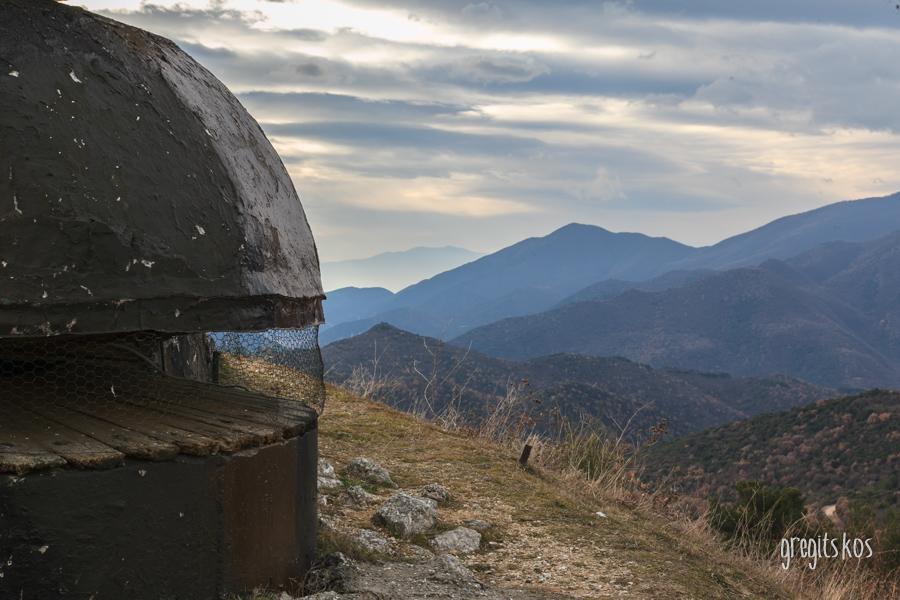


 “Agkistro” and the “hamam”(Turkish word for the steam bath- the contemporary spa) are absolutely connected to each other! A little further below the “Wooden Village” are the “hamams” of the village. The Byzantine hamam, the oldest Turkish bath, dates back to 950 AD. And is characterized as a real monument. In recent years, it has been expanded, utilized and framed by additional modern halls and a community hotel (“Hamam”,hamamagistro.gr, tel. 2323041420). It is built right next to the Byzantine hamam. Upon appointment (make sure to book it earlier in the day), you can enjoy your steam bath in a mysterious atmosphere: from the surrounding hot springs there is a steady flow of hot water at 37-38 ° C creating dense water vapor. One can see the dim light of candles (electricity does not exist in the old hamam, but there are newly built as well). The thermal waters spring through the rocks of Mount Agkistro and, as they travel to the surface of the earth, acquire the metallic components, which are mainly to be credited for their healing properties. The benefits of using the hamam include, among others, the relief of musculoskeletal pain, relaxation of the muscles and improvement of skin conditions. The odorless water effectively releases the toxins from the body and embellishes the skin. The hot springs of Agkistro are considered among the best in Europe, and are open for 365 days, 24 hours a day. Just take with you a swimsuit, a towel, slippers and a cap if it’s winter) !!!
“Agkistro” and the “hamam”(Turkish word for the steam bath- the contemporary spa) are absolutely connected to each other! A little further below the “Wooden Village” are the “hamams” of the village. The Byzantine hamam, the oldest Turkish bath, dates back to 950 AD. And is characterized as a real monument. In recent years, it has been expanded, utilized and framed by additional modern halls and a community hotel (“Hamam”,hamamagistro.gr, tel. 2323041420). It is built right next to the Byzantine hamam. Upon appointment (make sure to book it earlier in the day), you can enjoy your steam bath in a mysterious atmosphere: from the surrounding hot springs there is a steady flow of hot water at 37-38 ° C creating dense water vapor. One can see the dim light of candles (electricity does not exist in the old hamam, but there are newly built as well). The thermal waters spring through the rocks of Mount Agkistro and, as they travel to the surface of the earth, acquire the metallic components, which are mainly to be credited for their healing properties. The benefits of using the hamam include, among others, the relief of musculoskeletal pain, relaxation of the muscles and improvement of skin conditions. The odorless water effectively releases the toxins from the body and embellishes the skin. The hot springs of Agkistro are considered among the best in Europe, and are open for 365 days, 24 hours a day. Just take with you a swimsuit, a towel, slippers and a cap if it’s winter) !!!
 Two days are not enough to try the village taverns. We ate tasty zea pasta in “Don Pablo” but we did not get to taste the venison and other dishes of “Kyra Maria” (tel: 2323041144) and the kitchen of “Wooden Village”, for which we heard great comments! Check out the page: http://www.agistro.com/
Two days are not enough to try the village taverns. We ate tasty zea pasta in “Don Pablo” but we did not get to taste the venison and other dishes of “Kyra Maria” (tel: 2323041144) and the kitchen of “Wooden Village”, for which we heard great comments! Check out the page: http://www.agistro.com/
“Agkistro Action”, the first Alternative Tourism Office in Greece, organizes tours at the decommissioned northern fortifications (Fortresses Line of Metaxas). At the same time, “Agkistro Action” organizes activities in nature (cycling, mountaineering, archery, kayaking, Fliyng fox, etc.). A very good choice! Get detailed information on their highly organized website: www.agkistroaction.gr or call (tel. 2323043033 & 6980138846)
If you would like to bring home with you some local products visit the “Traditional Product Shop”, just before entering the village (tel. 2323041210 & 6974458809). We , on the other hand drove up to “Irakleia” (20 ‘) to get the original “Tzoumagias sausages”! (In Coco)
We bid farewell to Agkistro and the people we met there, full of expectations for our next visit! Why not have come back here in spring!
The title ” Hooked up in pleasure” was “stolen” from the name of the homonymous cafe in the village! We loved it!
 MORE ADOUT THE VILLAGE
MORE ADOUT THE VILLAGE
The beginning of the history of the village is lost in the depths of the ages. During the reign of Philip II of Macedonia, in the 4th century BC, iron and gold mines of Mount Agkistro, were providing valuable material, along with the mines of Pangaio, to the campaign of Alexander the Great in Asia. This era is also marked by the discovery of the warm waters that flow from the mountains, resulting in a strong human presence in the area for the centuries to come. The stone bath dates back to the Byzantine era, as well as the tower in the center of the village, which served as a clock in the 14th century. During the Ottoman domination the village was called “Tsigelli”, with the bey (Turkish ruler) of the region and its harem enjoying the warm waters of the bath, as the monument was the private hamam.
Agkistro has suffered severe disasters in all the difficult moments of modern history (Balkan Wars, World War I, World War II, and Civil War). Due to its particular geopolitical position, is has been a militarized zone for many years. At present there are about 400 residents in the village who are mainly engaged in agriculture, livestock, beekeeping, logging, and tourism.
In the summer they organize the three-day cultural festival “Without Frontiers” (1st week in August) with concerts by popular Greek artists, dance groups and good local food, while on the third day, there is a River Party at the Mills
ABOUT THE HAMAM 
We enter the hamam “prive”, by appointment, for half an hour or for an hour or even more if we want. We pay € 6.00 per person for half an hour (i.e. if we are a company of 4 people and we want the steam bath to ourselves for 1 hour, then we will pay a total of 40 €). The water is poured into a pool of 3×3 meters and depth of 1.20 m. At the peak hours it is difficult to find a free steam bath, so many people are even more comfortable in the post-hours! Attention: To the Byzantine Hamam priority is given to the residents of the “Hamam Hotel” and to those who stay overnight at the village. If it is winter, make sure you are warmly equipped because the new hamams are outside the hotel, so you have to go out and walk to the building or the car!
You can also get a massage. Ask for the services at “Hamam Hotel”
TIPS:
Distance
– Agkistro – Thessaloniki : 122 km
– Agkistro – Serres : 50 km
– Agkistro – Veroia: 191 km
– Agkistro – Rupel: 16 km, Agistro – Poroia: 50 km
Download the guide http://www.agistro.com/images/maps/Guide_FINAL.pdf
Keep in your mobile phone the site: http://www.agistro.com Find useful information about everything in the village!

by N.Psyharakis | Sep 3,2016 | Greece, islands
The first time we visited his beautiful island, George, our friend from Sifnos, told us: “Sifnos has an energy that you either accept it and worship the island, or you reject it and never come again.” After three years holidays’ in a row in Sifnos, guess what has happened! The DNA that builds our chromosomes has now a trickle of the “blue” of Sifnos!
As you understand, it’s a little difficult to tell you which places we visited and what we ate in all three visits. “So here are the highlights. And you’re lucky, to come along at the best!
How do you go to Sifnos? Just …take a boat from Piraeus. There are many itineraries offered during the day by various ferry companies. You’d better get the fast ferry. Three hours later you’ll be there! Here’s a tip: You will find it handy to have your car with you. Sifnos is a big island which means you need a means of transport. You can always rent one but we can’t guarantee the prices! If, on the other hand, you don’t have a car, no worries! KTEL with its frequent itineraries all over the island, will be at your service.
For a stay we will tell you a name: HOTEL NYMFES in Kamares (at the port). George (yes, it is the one that we mentioned above) and Moscha (his gentle sister) are our friends, we really can not tell you anything about their hotel: neither about the Greek, most traditional and handmade breakfast nor about the pool that will cool you off on the days when you are lazy enough to go to the beach, or the rooms that have a view to the harbor and the sunsets of Sifnos. No, we won’t tell you anything, so that you don’t think we are biased! Just look at the photos and draw your own conclusions.
 |
 |
Have you been settled in your room? Put on sunscreen and off to the sea. Sifnos has beaches for all tastes. From sunset and calm, without human intervention, to organized beaches with the comfort of sunbeds and umbrellas. Choose among the sandy beaches in Kamares, Vathi, Platis Gialos, Apokofto, Faros, the pebbled one in Vroulidia (hold your breath on the way back, walking the up cliff path!) And if you wish for a beach on rocks, then go to Chrysopigi. You know, there is the church of Panagia Chrisopigi! Exquisite! Most photographed sight! You may have heard about the many weddings taking place there.
We went to nearly all of them. Do you want to know our favourite ones? Kamares, at “Syrma” café, Wire (very polite people, free of charge sunbeds along your order. You’ll enjoy your coffee as well as their dishes ). Faros (Glypho), see that you go relatively early there, to catch up the shadowy spaces under the trees to lay your body and finally the Apokofto, which also has trees along the beach and you enjoy a view of Chrysopigi.

And now we reach our favorite theme. FOOD! We don’t know if you’ve heard, but Sifnos is the island of gastronomy! The Greek chef of the 20th century, Nikos Tselementes was born and first cooked here the famous Siphneian chickpea recipe. And of course, there is also a Gastronomic Festival named after Nicholas Tselemnedes. On September 2016, Artemonas organized the 10th festival in a row, and it has reached the point when the festival is slowly expanding to the rest of Greece and abroad as well. We also met the president of the Cultural Club of Sifnos Ms. Maria Nadali The success of the festival was more than certain being organized by such active members of this club. Visiting each pavilion and tasting the traditional delicacies of each place is, by no doubt, a form of happiness. Good food is also happiness (Yes, we ate a lot and we returned heavier)!

 And here’s what we tasted! In Kamares, if you want cooked food and delicious seafood, go to “Meropi”. If you want “gyros” or “souvlaki”, go straight to “Maria” at Avlemon. In case you wish for Italian flavours, we recommend the pizza house Da Claudio. You’ll eat well!
And here’s what we tasted! In Kamares, if you want cooked food and delicious seafood, go to “Meropi”. If you want “gyros” or “souvlaki”, go straight to “Maria” at Avlemon. In case you wish for Italian flavours, we recommend the pizza house Da Claudio. You’ll eat well!
In Apollonia you can choose “Dremon”, the Italian “Mamma Mia” and Art Restaurant Cayenne (a bit pricey but you will experience a cultural and delicious taste shock).
In Artemonas, visit Mosaic and the Yellow Sweet Shop Bike.

Finally, for something completely different try the Lebanese delicacies in Maiolica in Platis Gialos . Strong and spicy flavors in deliciously served dishes!
And when you are done with food, wouldn’t be nice to go for a drink? Oh, yes! You’re gonna go! You have a lot of choices, especially in Apollonia, but for a special experience choose Rabaga. A great multi-purpose place that combines food, drink, shopping and fun.
 Before we let you go back to what you read, we suggest that you go to Castro. Great location with panoramic view. If you are an early bird, then this is your place to be! A perfect sunrise spot!
Before we let you go back to what you read, we suggest that you go to Castro. Great location with panoramic view. If you are an early bird, then this is your place to be! A perfect sunrise spot!
P.S. 1: Hey!… We forgot to tell you about the church of Saint Symeon, at the top of the mountain, above Kamares! A 360 ° view! What’s more, at night, when it’s lit up, it looks like it’s flying!
 P.S. 2: Almonds and anthers cooked by Gregory in Artemonas! And the ceramics, a gift to mummy by Giannis Apostolides in Kamares
P.S. 2: Almonds and anthers cooked by Gregory in Artemonas! And the ceramics, a gift to mummy by Giannis Apostolides in Kamares
P.S. 3: Don’t forget to bring all the above home as souvenirs. The memory of Sifnos will be with you forever !!

 Carnival is celebrated everywhere across Greece, but it’s only in Naoussa that the Janissaries dance along the “patinada” rhythm. And it is this sound of the “zourna” approaching slowly and getting louder and louder as it gets closer, until you feel the tabor accompanying him pounding inside you, like a second heart! At that moment, the group of the “Janissaries and Boules” passes by you! Young and old Janissaries outcross their swords dancing “patinada”, a slow, sad song. The musicians are the last to follow the group, along with the leader of the group who checks everything around and instructs which songs will be played. If you don’t hear the zourna playing, you haven’t experienced the carnival in Naoussa!
Carnival is celebrated everywhere across Greece, but it’s only in Naoussa that the Janissaries dance along the “patinada” rhythm. And it is this sound of the “zourna” approaching slowly and getting louder and louder as it gets closer, until you feel the tabor accompanying him pounding inside you, like a second heart! At that moment, the group of the “Janissaries and Boules” passes by you! Young and old Janissaries outcross their swords dancing “patinada”, a slow, sad song. The musicians are the last to follow the group, along with the leader of the group who checks everything around and instructs which songs will be played. If you don’t hear the zourna playing, you haven’t experienced the carnival in Naoussa!














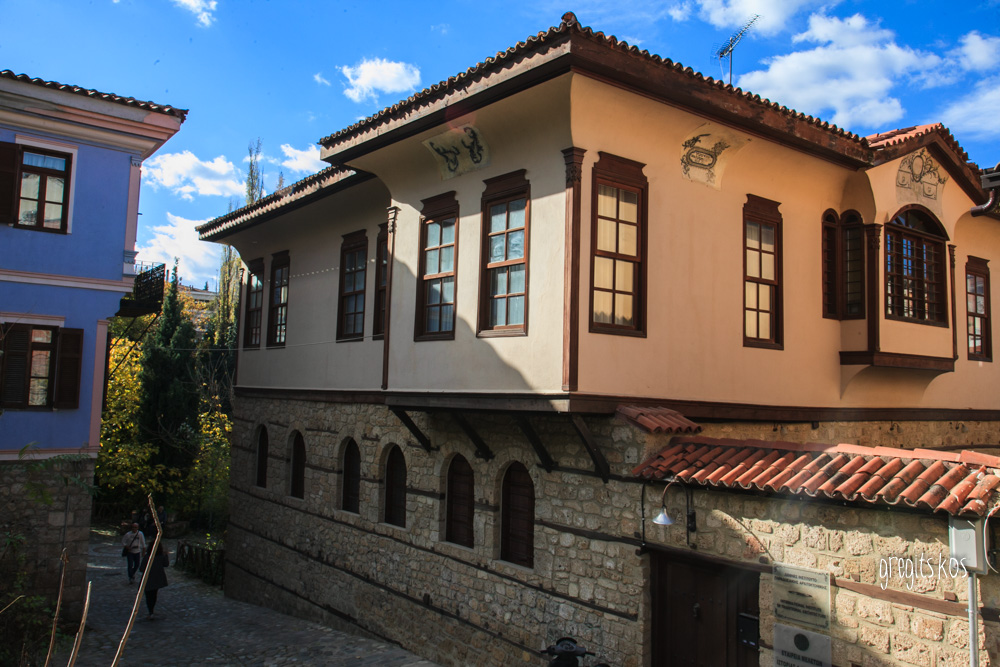



 The numerous mosques (14) in the city are remnants of the Turkish domination. Many were used as public Turkish baths. The city still maintains some buildings like the “Twin Baths of Sinan of Alatas” 14th century( soon to be restored). From the Old Cathedral, head to the city’s commercial center, a pedestrian complex with a large number of shops and many cafés / bars (many offer snacks as well) and some taverns.
The numerous mosques (14) in the city are remnants of the Turkish domination. Many were used as public Turkish baths. The city still maintains some buildings like the “Twin Baths of Sinan of Alatas” 14th century( soon to be restored). From the Old Cathedral, head to the city’s commercial center, a pedestrian complex with a large number of shops and many cafés / bars (many offer snacks as well) and some taverns.









